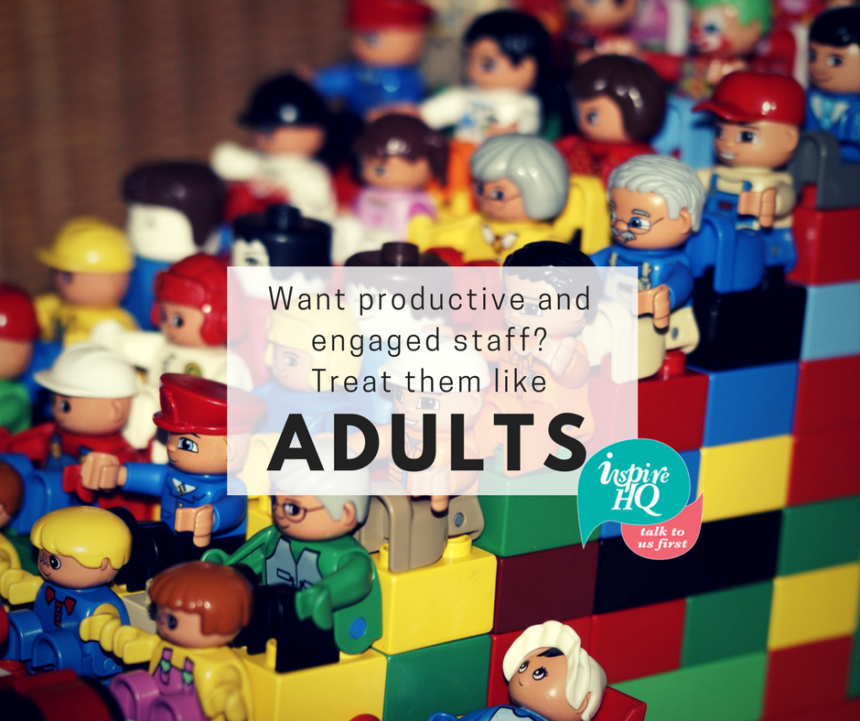Do any of these sound familiar to you?
- ‘Why can’t my staff take more initiative?’
- ‘No-one seems to have any common sense these days.’
- ‘Why do they bring all their problems to me?’
- ‘How do I get my staff to stop blaming others and be more accountable?’
- ‘Why do my staff only give the bare-minimum and then walk out the door at 5.01pm?’
The issues we are having with your staff aren’t that dissimilar to the ones we are having with our children, is that a coincidence?
We know that having the ‘right’ staff starts with recruitment. As business owners, managers, or HR professionals, we agonise over which candidate is the most competent and best cultural fit. Often, we are looking for someone who ‘uses their initiative’, ‘is self-managed’, and ‘has good problem solving and decision making skills’. Essentially, we are hiring competent high performing adults.
Why is it then, that at every place I’ve worked, only 10% of the workforce would be considered competent high-performers? Assuming our recruitment practices were reasonably sound, we have to look at how our culture stifles or discourages those high performers we’ve worked so hard to recruit.
Over the next three blog posts, I’m going to look at the traditional people management policies, practices and behaviours that are feeding this underperformance and lack of engagement. In my 15 years in HR management, I’m guilty of pushing this traditional approach as much as the next person. I’ve seen firsthand, both as a manager and HR practitioner, how we never get anywhere near the culture we want, doing what we’ve always done. It’s time for a radical change in how we manage our staff and it all comes down to trust.
I recently read a great quote by Paul Jacobson, ‘The Flipside of Treating Employees like Children’, “(lets) start with the assumption that (our) employees are adults capable of independent thought and getting their work done efficiently with appropriate guidance (guidance, as in leadership, not puppetry).” If you can’t trust your staff to get their work done and to make good decisions about their work, why did you hire them in the first place?
I want to start with our policies, how we develop and communicate them, what we put in them and how we enforce them.
Policy Development
In one of my earlier project roles, a key outcome was to review the policies and procedures. I came in expecting them to be a mess, but found a neat set of well written documents. Other than being a bit formal, I couldn’t see how this was going to keep me busy for 6 months. The fact that they were so neat, should have been the clue, they were never used. Staff didn’t understand them, they didn’t know when to use them and newer staff didn’t even know they existed.
Since that time, I have never done policy work in a vacuum. I actively seek insight from a range of staff who are directly impacted by the policy. Wherever possible, I do this before I even start drafting. The beauty in this process is that the document then becomes a conversation about what they need to know to perform their roles, as well as understanding the business’ expectations. Often the policies were much simpler and sometimes we decided that we didn’t need them at all! Once drafted, the policies always went out for feedback, before they were approved.
Policy Content
I was recently working with a great business, and part of my brief was to dig into their people management culture. I was surprised when one of their managers stated that to improve the underperformance of staff, he would write very detailed procedures for absolutely everything they did, then ask them to follow it to the letter. He then went on to say that if we were going to continue with this culture of treating our staff like children, then we might as well go the whole hog.
Lucy Adams, CEO of Disruptive HR, is challenging us to think differently about people management, particularly treating employees as adults. She asks us to consider ‘if our people policies are designed on the assumption that people come to work to do a good job and behave well or are they designed to protect the organisation from poor behaviour’.
Our policies shouldn’t be a detailed shopping list of everything our staff can’t do. They should be focused on the behaviour we want to see. They don’t need to be prescriptive, allow room for your staff to use their judgement.
Policy Enforcement
I know that HR and business owners/managers are often known as the fun-police. Stridently enforcing our carefully worded policies, in the belief that we are protecting our businesses from risk and avoiding any legislative breaches. Unfortunately taking such a controlling and directorial approach, decreases trust, hurts morale, and often increases your risk of claims and complaints.
If you’ve engaged staff in the development of the policy, your need to ‘enforce’ the policy is significantly reduced. Every time the policy is used, encourage your staff to give feedback on how it worked and refine them as needed. Yes, sometimes your staff will do the wrong thing. It’s important that you address that one individual, rather than smacking everyone around the head by ‘reminding them of their responsibilities’ or worse still, writing a new policy around this incident.
If you are in the process of developing or refining your policies, it would pay to ask yourself:
- How would I feel if this policy were applied to me?
- Have I sought enough feedback and insight from those it will directly affect?
- Does this policy focus on the outcomes we want, not the process, allowing staff to use their judgement?
- Will this policy help our staff do their job better by focusing on the behaviour you want to see?
- Can this policy be made simpler, more concise or is it even needed at all?
Treating staff as adults is a significant mind shift for so many of us. It requires high levels of trust, letting go of some of the control and allowing room for mistakes. But the rewards are engaged staff, who are more productive and more committed to their roles and our business.
Read Part 2 and Part 3 of this topic here.
Claire Huntington has over 15 years’ experience in senior and executive level human resource management and strategic leadership positions. Claire learnt HR under the wings of great mentors and through trial and error. She has a very practical hands-on approach to HR and management, and isn’t afraid to look outside the box. Claire is also mum to three primary-school aged firecrackers and is an avid photographer in her spare time.
Disclaimer: The material contained in this publication is of a general nature only. It is not, nor is intended to be, legal advice. If you wish to act based on the content of this publication, we recommend that you seek professional advice.

